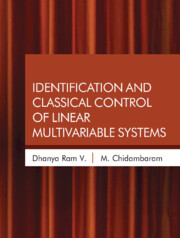Book contents
- Frontmatter
- Contents
- Preface
- Acknowledgements
- List of Abbreviations
- Notations
- 1 Models, Control Theory, and Examples
- 2 Identification and Control of SISO Systems
- 3 Introduction to Linear Multivariable Systems
- 4 CRC Method for Identifying TITO Systems
- 5 CRC Method for Identifying SISO Systems by CSOPTD Models
- 6 CRC Method for Identifying TITO Systems by CSOPTD Models
- 7 Identification of StableMIMO System by Optimization Method
- 8 Identification of Centralized ControlledMultivariable Systems
- 9 Identification of Multivariable SOPTD Models by Optimization Method
- 10 Identification of Unstable TITO Systems by Optimization Technique
- 11 Centralized PI Controllers Based on Steady State Gain Matrix
- 12 SSGM Identification and Control of Unstable Multivariable Systems
- 13 Control of Stable Non-square MIMO Systems
- 14 Control of Unstable Non-square Systems
- 15 Trends in Control ofMultivariable Systems
- Appendix A Identification of Unstable Second Order Transfer Function Model with a Zero by Optimization Method
- Appendix B For Chapter 3
- Appendix C For Chapter 7
- Bibliography
- Index
13 - Control of Stable Non-square MIMO Systems
Published online by Cambridge University Press: 31 July 2022
- Frontmatter
- Contents
- Preface
- Acknowledgements
- List of Abbreviations
- Notations
- 1 Models, Control Theory, and Examples
- 2 Identification and Control of SISO Systems
- 3 Introduction to Linear Multivariable Systems
- 4 CRC Method for Identifying TITO Systems
- 5 CRC Method for Identifying SISO Systems by CSOPTD Models
- 6 CRC Method for Identifying TITO Systems by CSOPTD Models
- 7 Identification of StableMIMO System by Optimization Method
- 8 Identification of Centralized ControlledMultivariable Systems
- 9 Identification of Multivariable SOPTD Models by Optimization Method
- 10 Identification of Unstable TITO Systems by Optimization Technique
- 11 Centralized PI Controllers Based on Steady State Gain Matrix
- 12 SSGM Identification and Control of Unstable Multivariable Systems
- 13 Control of Stable Non-square MIMO Systems
- 14 Control of Unstable Non-square Systems
- 15 Trends in Control ofMultivariable Systems
- Appendix A Identification of Unstable Second Order Transfer Function Model with a Zero by Optimization Method
- Appendix B For Chapter 3
- Appendix C For Chapter 7
- Bibliography
- Index
Summary
In this chapter, the simple centralized controller tuning methods – Davison method, and Tanttu and Lieslehto method – are extended to non-square systems with the Right Half-Plane (RHP) zeros. The proposed methods are applied by simulation on two examples – coupled pilot plant distillation columns and a crude distillation unit. The performances of the square and non-square controllers are compared.
Genetic algorithm (GA) optimization technique is applied for tuning of centralized and decentralized controllers for linear non-square multivariable systems with RHP zeros. Using Ziegler–Nichols (ZN) method, all the loops are initially tuned independently. To obtain the range of controller parameters, a detuning factor is used and this range is used to improve the range of GA search. Simulation studies are applied on a non-square (3 input, 2 output) coupled distillation column. ISE values show that centralized controllers designed by the GA technique give good performance when compared to the decentralized controllers designed by the GA method and other analytical methods. The method of designing decentralized PI controllers for non-square systems by relay auto-tuning method is also proposed in this chapter.
Introduction
Processes with unequal number of inputs and outputs often arise in the chemical process industry. Such non-square systems may have either more outputs than inputs or more inputs than outputs. Non-square systems with more outputs than inputs are generally not desirable as all the outputs cannot be maintained at the set points since they are over specified. The control objective in this case is to minimize the sum of square errors of the outputs with the given (fewer) inputs. For these systems, robust performance (with no offset) is impossible to achieve due to the presence of an inevitable permanent offset that results in at least one of the outputs.
More frequently encountered in the chemical industry are non-square systems withmore inputs than outputs. Here, better control can be achieved by redesigning the controller, eliminating the steady state offsets. Examples of non-square systems are mixing tank process (Reeves and Arkun, 1989), 2 × 3 system, Shell standard control problem (Prett and Morari, 1987), 5 × 7 system, crude distillation unit (Muske et al., 1991), 4 × 5 system, and so on. A common approach towards the control of non-square processes is to first ‘square up’ or ‘square down’ the system through the addition or removal of appropriate inputs (manipulated variables) or outputs (controlled variables) to obtain a square system matrix.
- Type
- Chapter
- Information
- Publisher: Cambridge University PressPrint publication year: 2023

